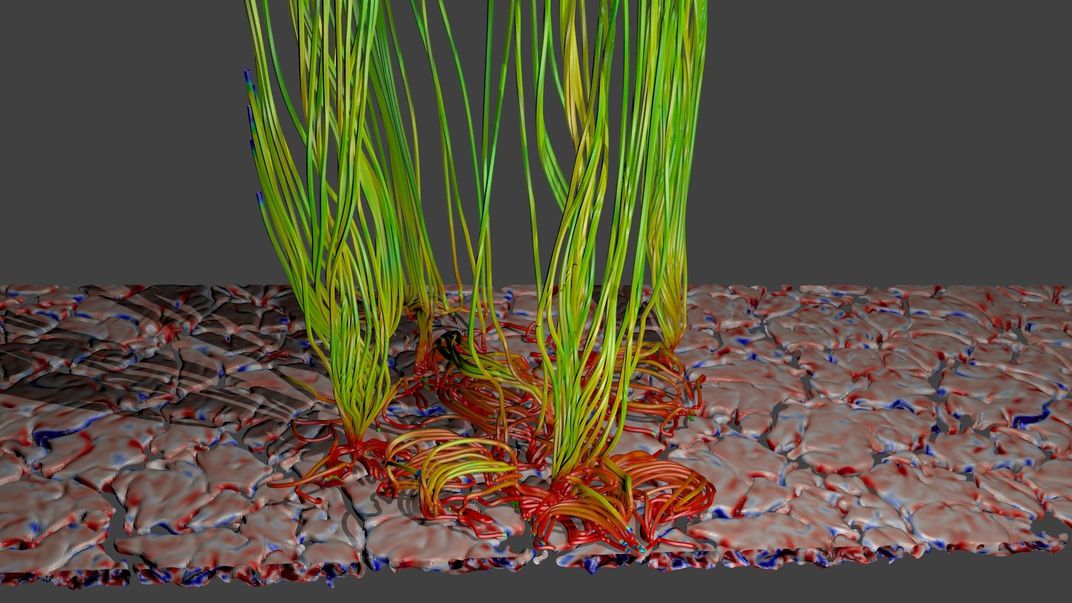A “Mangrove Forest” of Magnetism May Help Heat the Sun’s Corona
New simulations might explain why the sun’s atmosphere is bizarrely millions of degrees hotter than its surface
:focal(1338x914:1339x915)/https://tf-cmsv2-smithsonianmag-media.s3.amazonaws.com/filer/96/2c/962cf90f-6c04-4bff-a68b-f657aa216f80/magnetic-corona.jpg)
If you cook on a gas stove, the food heats faster when it's closer to the flame. But in seeming defiance of thermodynamics, that doesn't work when you're talking about the sun. While the solar surface is about 10,000 degrees Fahrenheit, the atmosphere can hit a whopping 9 million degrees in its outer reaches, called the corona, and scientists have been asking, "What's up with that?" for decades.
Now a team at the École Polytechnique in France thinks they have at least part of the answer. Using new computer models, they posit that the ultimate source of the corona's searing heat is a "mangrove forest" of magnetism that lies just underneath the surface we see, called the photosphere.
"Everyone knows that the energy is coming from below, and we know it's a lot of energy," says study leader Tahar Amari. The question has been what creates that energy and how it travels from the surface to the corona. That's where the new model, described this week in Nature, steps in.
The sun is made mostly of plasma, hot gas made of atoms that have had their electrons stripped away, creating a charge. When that kind of gas is rotating, it acts like an electrical generator, or a dynamo. In the new model, the sun's plasma creates these dynamos as it roils and churns. The dynamos in turn generate magnetic fields, which can store energy. All this occurs in the upper 900 miles of the sun—a small fraction of its 432,000-mile radius. The dynamos don't last long, about eight minutes on average, but it's enough that they can sometimes feed larger structures.
When the resulting magnetic fields twist, turn and cross each other, they can release their energy in a phenomenon called reconnection. Put two or more fields near each other, and the poles of those fields try to create new magnetic field lines with their nearest neighbors, rearranging the shapes of the fields in the process. Excess energy then gets expelled as heat, electromagnetic waves or kinetic energy, and that in turn gets pumped into the chromosphere, the layer extending about 1,200 miles from the photosphere to a region that transitions into the corona.
According to the model, the energy dump fuels eruptions of plasma into the chromosphere, which make waves akin to sound waves moving through the air. These are called Alfvén waves, after physicist Hannes Alfvén, who first proposed their existence in the 1940s. The Alfvén waves' energy gets dissipated in the corona, which then gets hot enough to reach the millions of degrees we observe.

Amari likens the whole system to a mangrove forest. At the bottom are the roots, which come together to form the trunks of the trees. The top of the trees is where the energy gets deposited. He noted that to get the kind of coronal heating we see, you need about 4,500 Watts per square meter from the surface, and that's what his model produces.
For now, the work is only a computer simulation, and there isn't yet a direct way to observe what's happening, Amari says. However, existing indirect observations of the sun make his model plausible. For instance, the coronal temperature doesn't seem to vary much with the 11-year sunspot cycle. "Sunspots are sensitive to the cycle—this magnetic field is not," Amari says. Sunspots are magnetic disturbances rooted deeper in the sun, so if the two phenomena are not linked, that would support Amari's model of a relatively shallow driver for coronal heating.
Another factor is the discovery of solar tornadoes, which show that some phenomena can transport energy from the surface to the chromosphere and corona, bolstering the model. In addition, observations of the solar surface show that the spectral lines of some elements are split into two or more components, which happens if there's a strong local magnetic field like the one the model describes.
Last year Jeff Brosius, a solar physicist at the NASA Goddard Space Flight Center in Greenbelt, Maryland, proposed that tiny flares called nanoflares were responsible for coronal heating. Nanoflares are caused by huge magnetic fields that loop through the corona. The magnetic field lines sometimes cross, creating current sheets that release energy as heat.
While the two versions differ in their specifics, they aren't necessarily contradictory. "The mechanism of the nanoflares is an open question," says Jim Klimchuk, a research astrophysicist at Goddard who wasn't involved in either study. "It could involve the reconnection of magnetic fields in the corona (the same process that creates Amari's mini eruptions below the solar surface and that causes them to deposit most of their energy in the chromosphere), or it could involve the dissipation of waves that are launched into the corona from below. I'm sure both things are happening. It's just a question of proportion."
According to Klimchuk, the new model is an important step in understanding this vexing solar mystery. "To my knowledge, [the dynamos producing eruptions in the chromosphere] have not been seen in other simulations, so it will be important to work out the details of this behavior and verify that it is correct," he says. "The chromospheric and coronal heating problem is not solved, but these results may provide important clues as to the path forward."
EDITOR'S NOTE: This article has been updated to clarify that dynamos have been seen before in solar models.